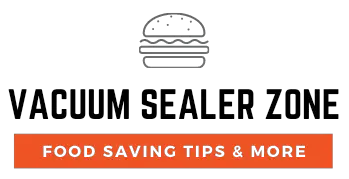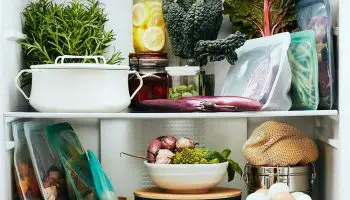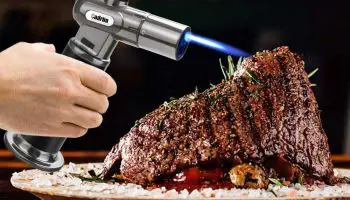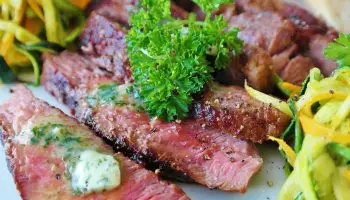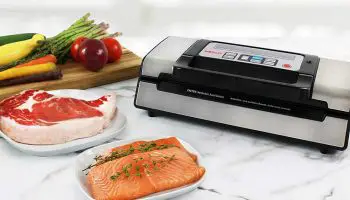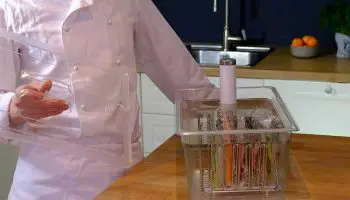Sous Vide, pronounced as soo-veed, is a slow method of cooking food in a vacuum bag under precisely controlled temperatures for a long time in a heated water bath. The name is a French word that means ‘under vacuum’.
Bruno Goussault, a French chef, introduced sous vide in the 1970s. The method has become popular in many kitchens since then; first commercially then in domestic kitchens.
Many chefs have received it well but some critics feel like the method is ‘cheating’ in the kitchen. But how does this technique work and how good is it? Let’s find out.
Do restaurants use sous vide?
Restaurants use sous vide and the method is gaining a lot of traction even in high-end restaurants. Well-seasoned chefs have been using this technique to prepare a wide variety of foods like meats, fish, eggs, fruits, grains, and others. Sous vide involves packaging food in a vacuum bag to avoid water from getting into contact with the food.
Chefs then place this bag in preheated water which has constant and regulated temperatures. Here, it slow cooks for longer periods than those of normal cooking. The method ensures food retains taste, texture, nutrients, and color without overcooking.
Steps of Sous Vide
As chefs go about this cooking process, they do not just drop vacuum-sealed food bags into a water bath and wait for it to cook. There is a process they follow but it’s still pretty simple.
The following are the steps:
1. Vacuum Seal Your Food
The very first step is to vacuum seal the food that you are preparing. Put your food in a bag and use a vacuum sealer to get rid of all the air.
You can also use the water displacement method to get rid of the air. Dip the bag in a water bath slowly, then when the water reaches above the food, seal your bag.
The food should not come into contact with the water in the bath. This can lead to it losing its flavors and texture something that sous vide tries to prevent.
2. Heat the water bath
Sous vide cooks in water and not normal flames. Place the vacuum-sealed food in the water.
You need to heat the water bath to enable the cooking of the food. The high temperatures of the water facilitate the slow cooking of food.
These temperatures should be constant throughout the cooking so you should ensure that you regulate them.
Different foods have different cooking temperatures but all temperatures remain lower than those of normal cooking.
3. Seasoning
Add taste to your food when it’s ready and cooked. Sous vide is simply vacuum-cooking and you will have to season your food afterwards to add flavor to it.
Do keep in mind that some foods will need seasoning before sealing and cooking them. So follow the steps of your specific recipe carefully.
If the recipe required seasoning after cooking, take it out, and season as you prefer. This process adds more color, flavor, and a good aroma to your food.
4. Grill or Sear
If you want a good sear to your meat, you can simply grill or sear it after sous vide. Because it’s fully cooked, it will not require a lot of time in the fire.
You can use a pan to sear for that mouth-watering brownish look, or you can just place it on the grill in direct fire for a couple of minutes.
Always let sous vide food to cool down first. Do not grill or sear it immediately afterwards as it can overcook.
Why Sous Vide is Beneficial to Restaurants
Sous vide is great for restaurants and below I have listed some reasons why:
Great Taste
Sous vide ensures that a food’s natural juices remain intact inside the vacuum-sealed bag. This makes sure that the food retains its taste, moisture, and texture.
With no water or direct heat coming into contact with the cooking food, all nutrients, proteins, and vitamins remain within it.
No Waste
Sous vide foods cook slowly. They have circulators that regulate the temperatures ensuring they remain low and controlled all through.
This prevents overcooking which is very prevalent with direct flames. Overcooked foods lose their taste and texture leading to waste.
Sometimes high temperatures may lead to food drying out or getting burnt. Burnt food is not only terrible in taste but also in appearance and restaurants cannot serve that.
Sous vide foods do not have any chances of overcooking or even undercooking. Immersion circulators and thermometers ensure that temperatures do not get too high or too low.
Sous vide is slow and this makes food to cook perfectly. Food does not cook in patches either. The method distributes heat evenly to every part of it making it cook evenly.
Time Efficient
Busy restaurant kitchens can really benefit from sous vide. Chefs only need to place vacuum-sealed food bags in a heat regulated water bath and leave it to cook.
They are not required to keep checking or stirring the food as if it was cooking normally. This gives them free time to do other things in the kitchen.
Sous vide is also time-efficient because a chef can prepare more food in advance and refrigerate it in vacuum bags afterwards.
A chef will take out ordered potions one at a time and sear them for serving only when required. This will save not only preparation time but also the fuel used.
Low Risks of Contamination
Sous vide has low risks of contamination. Because you already vacuumed and sealed it, you cannot indulge directly with it.
You can only touch it after cooking. This greatly reduces the risks of bacteria contaminating the food.
Recap
Many restaurants from big chain hotels to popular fast-foods have adopted sous vide. Reputable chefs are using the method to enhance their old recipes and even create new ones.
Whether you are a restaurant owner or just want to try out some restaurant sous vide food, don’t shy away from this growing trend. It’s worth a chance.
